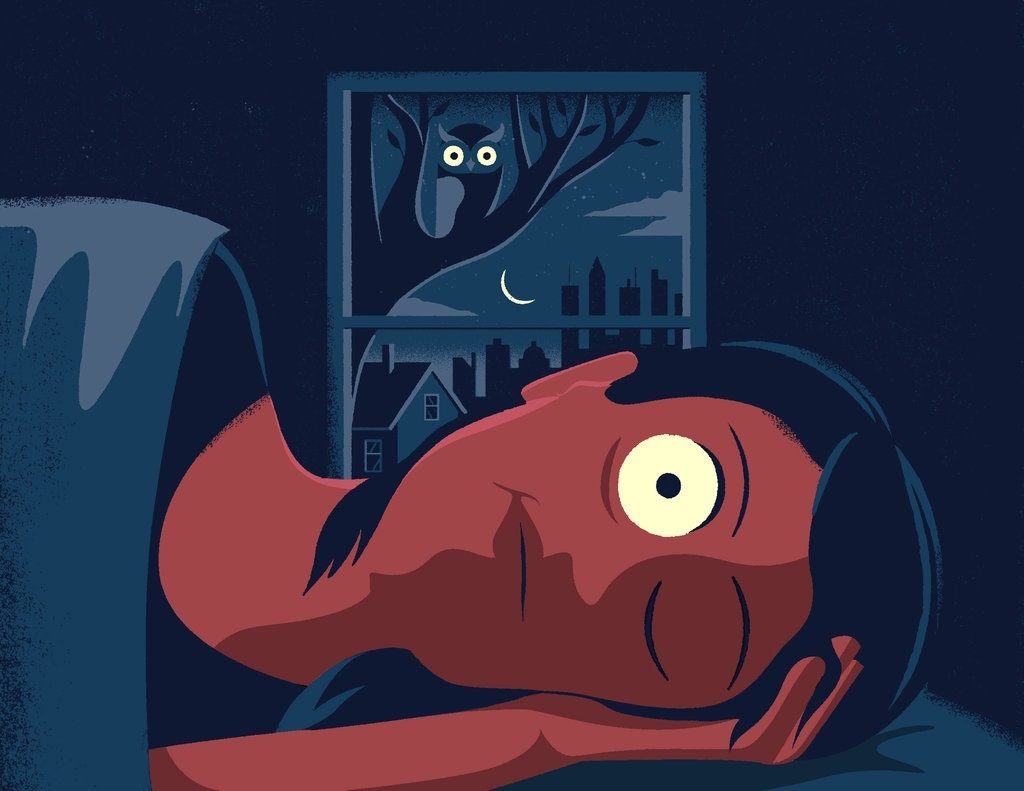
What it’s like living with a chronic circadian rhythm problem
The New York Times
Oct. 28, 2019
by Vanessa Barbara
Contributing Opinion Op-ed Writer
SÃO PAULO, Brazil — It’s hard to feel normal when you wake up at 4 p.m. every day.
No, I’m not a nurse who works the evening shift. No, I’m not the hard-partying heir to a Brazilian agribusiness fortune. And before you think it, I’m not lazy, either — I’ve written seven books so far! I sleep until the late afternoon because I’ve finally learned, after fighting it for years, that it’s better to come across as pathetic than to be always exhausted, depressed or sick.
I have a severe case of delayed sleep phase syndrome, a chronic misalignment of the body’s circadian rhythms with the daily light-dark cycle of our environment. The phrase “night owl” doesn’t really do it justice; my natural bedtime is around 6 a.m. While we as a culture are gradually becoming more aware of the many ways that bodies can differ from the norm, much of the world still takes for granted that people sleep at night and are awake during the day.
Not me. I miss having lunch.
According to conventional wisdom, going to bed early and waking up with the birds is a mere matter of habit and will power. This misconception is widespread, even among doctors. And for a long time, I believed it.
I spent years taking melatonin and Ambien in order to fall asleep by 2 a.m.; I used to wake up at 11 a.m. and then spend the rest of the day on stimulants such as Provigil and Ritalin. Yet I was always tired and depressed — the outcome that so often results when we try to force ourselves to be different from what we naturally need to be.
The last two decades have seen rapid advances in the field of chronobiology, the study of the biochemical clocks that keep our natural physiological rhythms. The 2017 Nobel Prize in Medicine, for instance, was awarded to three American geneticists for their discoveries of molecular mechanisms controlling the circadian rhythms in fruit flies.
What we’ve learned from this research is that circadian rhythms affect not only when we wake and when we sleep, but almost every facet of how we live. They regulate, among other things, body temperature, the cardiovascular and digestive systems, behavior and locomotive activity, and metabolic, cognitive and immune functions.
There are variations on the spectrum of what’s normal — people can be naturally more inclined toward morningness or eveningness. And circadian rhythms, though they mostly come built-in, can be adjusted, somewhat. Sunlight leads to wakefulness; cooler temperatures push people toward sleep. This is why standard-type insomniacs are encouraged to practice what is known as “sleep hygiene”: avoiding artificial light at night, for instance, or other forms of stimulation.
But this sort of thing does not work for me.
My sleep routine is more hygienic than the middle of an operating theater. (In fact, I’m writing this essay using blue-light blocking glasses, which might not be super effective, but at least they are bright orange and make me look like a visitor from the future. Small joys!) I could lie perfectly still at night for hours, listening to classical music or meditating, and I wouldn’t fall asleep until my body says it’s time.
For many, including myself, this syndrome is an invisible but real burden. For some, it is even a disability. When we are forced to live out of sync with our internal clocks, our health suffers. The mismatch between internal time and environmental time has been linked to problems including depression, diabetes, obesity and poor cardiovascular health. Our immune systems become a mess. Many night-shift workers have similar problems; for us, a traditional 9-to-5 schedule is the equivalent of night-shift work.
This happens because, even if we force ourselves to wake up early, our metabolism is not ready to perform simple tasks such as properly digesting a meal, for example — we do not produce as much insulin in the morning as normal people do. Our core body temperature also follows an internal rhythm, producing sleepiness or alertness much later. This is true as well for the release of cortisol, melatonin and other hormones essential to the sleep-wake cycle. In the morning, our eyes might be open, but, for all intents and purposes, we are still sleeping.
And it’s no use getting exhausted and deliberately “undersleeping” with the intention of falling asleep early the next day — a recommendation I’ve heard a lot, including from doctors. Circadian rhythms operate independently of the sleep-pressure system. This is the case even among “normal” people: Even if you slept miserably last night and woke up very early, it is unlikely that you’ll fall asleep at 6 p.m.; that’s because your circadian rhythms are cycling on as usual, unaffected by your lack of sleep. Your attempt to hit the sack would clash with something called the “wake-maintenance zone,” a three- to four-hour interval of maximum physiological alertness. (In normal sleepers, it occurs from 6 p.m. to 9 p.m.)
Delayed sleep phase syndrome has a genetic basis, as my own unscientific sample demonstrates: My mom also has it, though her case is not so extreme. Apart from that, other mechanisms can account for the disorder. Some studies indicate that our built-in circadian period might be unusually long (say, 25 hours instead of 24); others find dysfunction in our homeostatic sleep drive, a reduced response to the phase-resetting effects of daylight, or an excessive response to the sleep-delaying effects of artificial evening light. There is, as of yet, no cure — only short-term fixes that include the use of a light therapy box and the administration of well-timed melatonin pills. But in the long run, most of us fail to adapt.
Here’s the thing, though. If left to our own devices — if allowed to follow our own biological clocks — we sleep just fine.
Individuals with extreme cases of the syndrome are unable to work conventional jobs. We are also famously unreliable at keeping appointments and participating in diurnal social activities. We learn to make excuses and tell lies. I often say that I work nights, which is true — it’s just not the whole story. Most people respect work-related excuses, but sneer at health conditions they’ve never heard of.
That’s the worst thing about having a circadian rhythm disorder: living in a society that places a moral value on the time your alarm clock goes off. Most cultures emphatically equate early rising with righteousness: As we say in Brazil, “God helps those who wake up early.”
But we late risers are fighting back. In fact, we’ve been plotting while you sleep. For a while now, we’ve been gathering on mailing lists and in online support groups. We share specialists’ names, and new lines of treatment and research; we discuss mandatory accommodations and disability pensions.
Above all we find one another. There is a lot to be said about the therapeutic effect of meeting people who share your dramas: “How do you cope with the checkout time in hotels?” “How many times did you have to wake up early this week only to make a phone call?” “What do you do when maintenance people say they will come between 8 a.m. and 2 p.m.?”
And in recent years, there has been an increasing trend among people with the syndrome for self-acceptance. Instead of trying desperately to trick our biological clocks — and paying the price with our health — we are choosing more and more to embrace this condition as part of who we are. We change professions and give up on certain activities (goodbye, complimentary breakfasts!). We take precarious freelance jobs that enable us to work within our natural sleep-wake cycle. We reframe our ambitions. We keep early appointments to a bare minimum. We hire morning nannies and beg our partners for understanding. We try not to punch people who say it’s only a matter of will power.
And if anyone asks, we do work from 9-to-5 — 9 p.m. to 5 a.m.
Vanessa Barbara is the editor of the literary website A Hortaliça, the author of two novels and two nonfiction books in Portuguese, and a contributing opinion writer.
A version of this article appears in print on Oct. 29, 2019, Section A, Page 31 of the New York edition with the headline: Not Your Average Insomniac.

